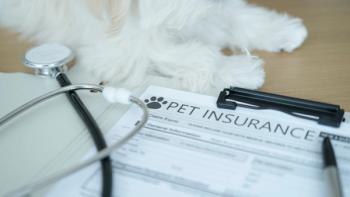
Watch out for tax law obstacles when borrowing
IRS takes special interest in corporate loans to shareholders
Borrowing funds for many veterinarians often means a loan from the veterinarypractice's principal or shareholder.
Or, in many cases, the principal or shareholder borrows the funds fromthe veterinary practice.
Either way, our tax laws create a number of obstacles that must be overcomein order to avoid the penalties and corresponding higher tax bills thatcan result from an Internal Revenue Service (IRS) restructuring of the transaction.
Loans and advances made to so-called "related parties" arequite common in many closely held veterinary practices and businesses. Corporateloans to shareholders are probably the most commonly seen by IRS auditors,with advances from shareholders to the incorporated veterinary practicerunning a close second, particularly in the early years of closely-held,but thinly capitalized, corporations.
The IRS's interest in these transactions stems from the tremendous potentialfor tax avoidance, inadvertent or intentional. Consider one basic rule thatis particularly applicable to small incorporated veterinary practices usingthe accrual method of accounting. Quite simply, interest payable on loansmade to related parties might not be deductible until it is included inthe income of the related payee.
Less formal loans, without stated duration or interest, are at leastas common as the more formal transactions already mentioned. Under our taxrules, these are treated as "demand" loans and, unless extremelysmall, are subject to the provisions governing "imputed interest."
Imputed interest
Section 7872 (Below-Market-Rate-Loans) of our basic tax law, InternalRevenue Code, treats "foregone" interest on all below market rateloans as transferred from the lender to the borrower as of the last dayof the calendar year and re-transferred immediately from the borrower tothe lender as interest.
When an incorporated veterinary practice makes an interest-free (or low-interest)loan to its shareholder, in the eyes of the IRS, the shareholder is deemedto have received a nondeductible dividend in the amount of the foregoneinterest while the corporation receives a like amount of interest income.
Fortunately, there is a $10,000 de minimis exception for compensation-relatedand corporate/shareholder loans that do not have tax avoidance as one ofthe principal purposes.
If the corporate loan is made to an employee, someone unrelated to ashareholder, the scenario is similar except:
* Foregone interest is characterized as additional compensation to theemployee.
* The corporation receives deemed interest in a like amount.
* The corporation can deduct the amount of foregone interest as a compensationexpense but may be liable for employment taxes on the additional wages.
When a below-interest rate loan is made between related entities, ora shareholder makes a loan to his or her incorporated veterinary practice,the adjustments resulting after imputing the interest are:
* The lender receives interest income in the amount of the foregone interest.
* The borrower has deemed interest expenses in a like amount.
Although this transfer of taxable income between entities may appearto be offsetting, there can be a significant tax impact on the reallocation,depending on the relative tax benefits of the borrower and the lender andthe deductibility of the expense deemed paid.
"Controlling" not a factor
Jones Animal Clinic, PC, was a closely held, incorporated veterinarypractice owned by William and Charles Jones and Steve Smith.
In 1994, Jones Animal Clinic made interest-free loans to William andCharles as well as to entities in which they had interests. All of the loansbut one were evidenced by promissory notes.
After the IRS determined that there was imputed interest, the corporationpetitioned the U.S. Tax Court, arguing that Section 7872 doesn't apply toa loan to a shareholder without a controlling interest in the corporationor to a loan to an entity in which no shareholder of the lending corporationpersonally holds a controlling interest. The corporation also argued thatthe IRS cannot make an imputed interest determination against the corporationwithout making corresponding adjustments to the shareholders' income taxes.
Unfortunately, the Tax Court felt otherwise.
First, the court rebuffed Jones' assertion that Section 7872 appliesonly to corporate loans to a controlling shareholder because the law usesthe term "shareholder" rather than "shareholders." Thecourt noted that the law refers to "any" shareholder, thus layingwaste to that argument.
The Tax Court also found it logical to treat such loans as being fromthe lender (Jones) to the indirect participant (its shareholders) throughthe business entity. In that way, the whole amount of the loan is attributedto the shareholder and any benefit ultimately received by nonshareholdersflows from the shareholder, not from the lending corporation.
Stock or loan?
When IRS examiners review the loans from shareholders and the commonstock accounts of many veterinary practices, they frequently encounter thincapitalization.
Thin capitalization occurs when there is little or no common stock, andthere is a large loan from the shareholder. A special section of the taxlaw, Section 385, was enacted specifically to determine whether an interestin a corporation should be considered as stock or as indebtedness.
The IRS' objective when it encounters thin capitalization is to converta portion, if not all, of the loans from the shareholders to capital stock.Naturally, this conversion requires an adjustment to the interest expenseaccount because, at this point, the loans will be considered nonexistent.The interest paid by the corporation, which has been disallowed by the IRSexaminer, will now be classified as a dividend at the shareholder levelto the extent of earnings and profits.
The courts have not always supported the IRS' efforts to classify shareholderloans as stock in thinly capitalized veterinary practices and businesses.In the eyes of the courts, equity is considered to be high risk. Money loanedis generally considered to be low risk. Thus, to lend money to one's corporationis, in effect, limiting the risk because equity is only allowed a capitalloss, but loans can be afforded the benefit of being classified as ordinarylosses.
Loan = taxable transaction
In one recent situation, the tax court ruled that a lawyer's loan fromhis pension plan was a taxable distribution-plus penalties.
Clayton W. Plotkin practiced law through a professional corporation inwhich he was the only director, officer and shareholder.
The corporation adopted a pension plan and hired an attorney to run it.Under the plan's loan policy, Plotkin could apply for a loan that didn'texceed half of his non-forfeitable account benefit or $50,000. If the loanwas not used to purchase a principal residence, the plan required repaymentwithin five years.
The plan administrator authorized a $25,000 loan to Plotkin who agreedto repay the loan in monthly installments. After the plan was terminated,Plotkin recognized the outstanding balance on the promissory note as a distributionand reported that "distribution" with an early distribution penaltyon his income tax return.
Unfortunately, the original promissory note did not include a balloonpayment at the end of five years.
The tax court rules that if Plotkin were allowed to restructure the promissorynote as containing a balloon payment, it would violate the rules (Section72) for early distributions form a pension plan. What's more, the balloonpayments could not be characterized as "substantially level" asrequired under the tax rules governing pension plan distributions. Thus,the entire loan was a taxable distribution.
Loans gone bad
Under our tax laws, a business bad debt deduction is not available toshareholders who have advanced money to shareholders who have advanced moneyto a corporation where those advances were labeled as a contribution tocapital. A noncorporate taxpayer who incurs a loss arising from his guarantyof a loan is, however, entitled to deduct that loss but only if the guarantyarose out of his trade or business-or in a transaction entered into forprofit. If the guaranty was connected with a practice or business, the resultingloss is an ordinary loss for a business bad debt.
If the guaranty was not connected with a practice or business, but wasprofit inspired, the resulting loss is a short-term capital loss for nonbusinessbad debt. No deduction is available if the guaranty payment or if the guarantywas entered into after the debt became worthless.
Since the tax treatment accorded business bad debts and nonbusiness baddebts differs, the taxpayer must show that his dominant motivation in makingthe payment was business-related in order to obtain the more favorable taxtreatment.
Obviously, there's more to lending or borrowing money between a veterinarypractice and its principals/shareholders than taking money from one pocketand putting it into another pocket. Even claiming a tax deduction for baddebts hinges on how those loans are structured - and whether they're legitimateunder our tax rules.
Newsletter
From exam room tips to practice management insights, get trusted veterinary news delivered straight to your inbox—subscribe to dvm360.






